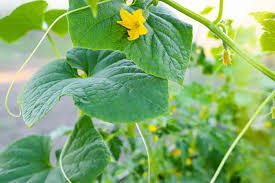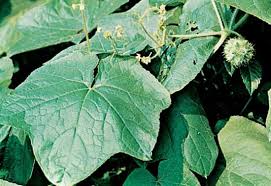Cucumber leaves are the foliage of cucumber plants (Cucumis sativus), which are commonly grown for their edible fruits. These leaves are an integral part of the cucumber plant and play a crucial role in the plant’s overall health and productivity. Here’s a description of cucumber leaves:
Cucumber leaves typically have a broad, palmate shape, which means they are divided into several lobes that radiate from a central point, resembling the shape of an open hand or a star. The size of cucumber leaves can vary, but they are generally around 4 to 8 inches (10 to 20 centimeters) in diameter.
The color of cucumber leaves can range from medium to dark green, depending on the variety and the plant’s health. Healthy leaves are vibrant green, indicating that the plant is receiving adequate nutrients and sunlight.
Cucumber leaves have a slightly rough texture due to small, fine hairs that cover the surface. These tiny hairs, known as trichomes, can give the leaves a somewhat fuzzy appearance and contribute to the plant’s defense against pests and environmental stressors.
The leaves have a prominent network of veins that run throughout the leaf blade. These veins transport water, nutrients, and sugars within the plant. The veins are often a lighter shade of green compared to the rest of the leaf.
Cucumber leaves are arranged alternately along the stems of the plant. This means that each leaf emerges from the stem at a different point, rather than directly opposite each other.
Cucumber plants are known for their vigorous and sprawling growth habit. As the plant grows, its leaves provide a lush canopy that helps shade the soil and conserve moisture. This can be particularly important in hot and sunny climates.
Cucumber leaves serve several important functions for the plant. They are responsible for photosynthesis, a vital process where the plant converts sunlight into energy to fuel its growth and development. The leaves also help regulate the exchange of gases (such as oxygen and carbon dioxide) with the environment.
The color and appearance of cucumber leaves can provide valuable information about the plant’s health. Pale or yellowing leaves may indicate nutrient deficiencies, while brown or black spots could be a sign of disease or pest damage.
While cucumber leaves are not typically consumed as a food source, they are sometimes used in traditional herbal remedies for various ailments. However, it’s important to note that some parts of the cucumber plant, including leaves, contain compounds that could potentially be toxic in large amounts, so caution is advised.
Cucumber Leaves : Economic Importance, Uses and By-Products

Cucumber leaves, while not as widely utilized as the fruit itself, do have some economic importance and potential uses.
Here are a few:
1. Culinary and Edible Uses: Cucumber leaves are sometimes used in culinary preparations, especially in certain traditional cuisines. They can be added to salads, soups, stews, and pickled dishes. In some cultures, young cucumber leaves are cooked and consumed as a vegetable, similar to spinach or other greens.
Example: In Korean cuisine, cucumber leaves are used in dishes like “oi namul,” a seasoned vegetable side dish.
2. Medicinal and Herbal Uses: Cucumber leaves contain certain compounds with potential health benefits. They are believed to have diuretic, anti-inflammatory, and antioxidant properties. In traditional medicine, cucumber leaves have been used to make infusions or extracts for various purposes, such as promoting digestion and treating skin conditions.
3. Livestock Feed: Cucumber leaves can be used as fodder for livestock, particularly in areas where feed resources are limited. While the leaves might not be the primary feed source, they can contribute to the diet of animals like cattle, goats, and rabbits.
4. Composting and Soil Enrichment: Cucumber leaves, like other plant materials, can be composted to create nutrient-rich soil amendments. Composting cucumber leaves along with other organic matter can help improve soil structure, water retention, and nutrient content.
Read Also: Cucumber Stolons (runners): Economic Importance, Uses and By-Products
5. Cultural and Decorative Uses: In some cultures, cucumber leaves are used for decorative purposes, such as garnishing plates or creating visually appealing arrangements. While not a widespread practice, this can add aesthetic value to culinary presentations.
6. Traditional Crafts and Art: In some traditional crafts, cucumber leaves can be used for weaving or creating decorative elements. While not a common practice, skilled artisans might incorporate dried cucumber leaves into baskets, hats, or other woven items.
7. Natural Pesticide and Fertilizer Production: Cucumber leaves, like many other plant materials, can be used to create natural pesticides and fertilizers. Extracts from cucumber leaves might contain compounds with insecticidal or repellent properties that can be used in organic pest management.
8. Educational and Research Purposes: Cucumber leaves can be valuable in educational settings for teaching students about plant biology, anatomy, and ecological interactions. Researchers might also study cucumber leaves for their nutritional content, chemical composition, or potential pharmaceutical applications.
9. Ethnobotanical Studies: Cucumber leaves can be of interest in ethnobotanical studies that explore the traditional uses of plants by different cultures. Documenting and preserving knowledge about how cucumber leaves have been historically utilized can contribute to our understanding of local customs and practices.
10. Experimental and Innovative Applications: As research and technology advance, new uses for cucumber leaves may emerge. Innovators and scientists might find ways to extract valuable compounds or develop novel products from cucumber leaves, expanding their economic potential.
The Products and By-products That Can Be Derived From Cucumber Leaves

Cucumber leaves, while not as commonly utilized as cucumber fruits, do have some potential uses and can yield a few products and by-products.
Here are some examples and explanations:
1. Herbal Teas: Cucumber leaves can be dried and used to make herbal teas. These teas are believed to have potential health benefits, including promoting hydration and providing antioxidants. To make cucumber leaf tea, simply dry the leaves, crush them, and steep them in hot water.
2. Natural Pesticides: Cucumber leaves contain compounds with insecticidal properties. They can be used to make a natural pesticide spray to control certain pests in gardens. To create the spray, blend cucumber leaves with water, strain the mixture, and spray it on plants as a non-toxic alternative to chemical pesticides.
3. Compost and Mulch: Cucumber leaves can be composted along with other organic materials to create nutrient-rich compost for gardening. They can also be used as a natural mulch to help retain moisture, suppress weeds, and improve soil structure in gardens.
4. Fertilizer: Cucumber leaves can be used as a source of green material in composting, contributing to the nutrient content of the compost. The compost can then be used as a fertilizer to enrich the soil in gardens.
Read Also: Cucumber Sepals: Importance, Uses and By-Products
5. Livestock Feed: While not as common, cucumber leaves can be fed to certain types of livestock, such as rabbits or guinea pigs, as part of their diet. Always research which animals can safely consume cucumber leaves before using them as feed.
6. Soap and Skincare Products: Extracts from cucumber leaves can potentially be used in soap and skincare products due to their potential skin-soothing and moisturizing properties. These extracts may provide a natural source of nutrients for the skin.
7. Crafts and Art Projects: Dried cucumber leaves can be incorporated into crafts and art projects. They can be pressed and preserved in resin, used in handmade paper, or added to decorative arrangements.
8. Educational Purposes: Cucumber leaves can be used for educational purposes in science experiments, particularly related to plant biology, photosynthesis, and transpiration. They can also be used to demonstrate various gardening and horticultural concepts.
9. Culinary Uses: While cucumber leaves are not commonly consumed, they can be used sparingly in certain culinary applications. Young and tender cucumber leaves can be used in salads, wraps, or as a garnish. They may add a mild cucumber flavor to dishes.
10. Natural Dye: Cucumber leaves contain chlorophyll, which can be used as a natural dye for fabrics and paper. Boiling cucumber leaves in water can extract the chlorophyll, and the resulting liquid can be used to create green dyes.
11. Aromatherapy and Potpourri: Dried cucumber leaves can be added to potpourri mixes for their subtle aroma. They may also be used in aromatherapy preparations, although their scent is generally mild.
12. Research and Scientific Studies: Cucumber leaves, like other plant materials, can be used in scientific studies for research purposes. They may be used to study plant biology, physiological responses to stress, or the effects of various treatments on plants.
13. Biofuel and Biomass: In the context of biomass production for renewable energy, cucumber leaves, along with other agricultural residues, could potentially be used as a feedstock for biofuel production through processes like anaerobic digestion or fermentation.
14. Educational Workshops: Cucumber leaves can be employed in gardening workshops, nature-themed events, or educational programs to teach people about plant cultivation, sustainability, and the role of plants in ecosystems.
15. Traditional Medicine and Folklore: In some cultures, cucumber leaves have been used in traditional medicine for their potential health benefits, such as soothing skin irritations or reducing puffiness around the eyes. However, these uses should be approached with caution and are not a substitute for professional medical advice.
In conclusion, remember that when exploring these potential uses, it’s important to consider safety, ethical sourcing, and sustainable practices. Always verify information and conduct appropriate research before using cucumber leaves or any plant material for various purposes.
Read Also : Wool Production: Complete Production Guide
